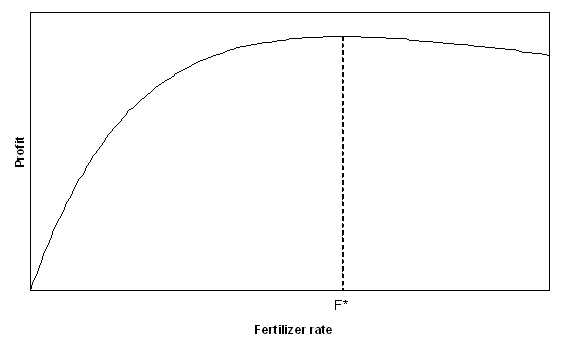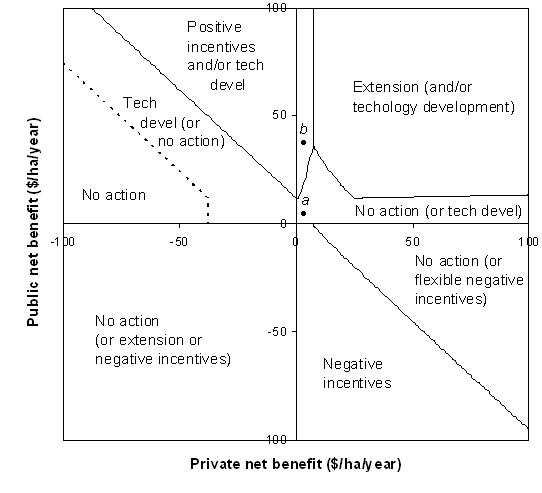118 – Farmers over-using chemicals
Why do some farmers apply more agricultural chemicals (fertilizers, herbicides, pesticides) than seems to be good for them, let alone for the environment? What should governments do about it?
I’ve just finished reviewing a research paper that asks why some farmers apply excessive rates of fertilizers, and the same question could be asked of herbicides and pesticides. Coincidentally, I was also asked a question about it at a conference presentation I gave last week, so here is my perspective on the issue.
If it was just that the farmers were wasting a bit of money, it wouldn’t be a particular policy concern, but given the likelihood of environmental costs from nutrients or pesticides entering the environment, it does become an issue that potentially justifies a policy response.
Commentators on this issue seem to get particularly frustrated when calculations show that farmers could actually increase their profit by cutting their use of chemicals, and yet they persist in using high chemical rates. There are several possible explanations for this observation:
(a) The farmers are misguided, or are not paying attention. Maybe they are all following common practice amongst their peers without thinking deeply about the consequences, but that begs the question of how the common practice emerged. As a rule I think it is safer to assume that there are good reasons for farmers’ observed behaviour.
(b) The farmers are getting poor advice. Maybe they are following the recommendations of chemical companies who have a vested interest in selling more of their products, or from agronomists who focus on yield instead of profit.
(c) The calculation of profit is inaccurate. That’s always possible. The calculations may have used inaccurate assumptions, or may have failed to capture the heterogeneity of farming situations. Mind you, if that were the case, you’d expect recommended rates to be sometimes above and sometimes below what farmers generally do, whereas “below” seems to be more common in practice. One possibility that would bias recommended rates downwards is the failure to consider carry-over benefits in future years from using an input this year. This is particularly important in the case of herbicides, and can be relevant to fertilizers and pesticides.
(d) There are potential profit gains from cutting rates but they are too small to encourage farmers to change their approach. This is almost certainly a factor. It is almost universally observed that profit functions are flat in the region of the optimal input rate (Pannell, 2006). Figure 1 shows a typical example. If a farmer’s current fertilizer rate is greater than F*, he or she could increase profits by cutting back to F*, but the gain in profit from doing so would be small. This doesn’t explain why the farmer’s current rate is greater than F*, but it may explain why it doesn’t change.
Figure 1. Profit functions are typically flat in the region of the optimal input rate.
(e) Factors other than profit are influencing their behaviour. This, too, is likely to be part of the explanation. One issue is risk. Note that the profit curve in Figure 1 has a steeply rising section followed by a wide flat area. In practice, a farmer does not know where the rapidly rising area finishes, so there is a motivation to put on more fertilizer just in case the steeply rising section is wider than average this year. The cost of putting on too much fertilizer is small, but the cost of putting on too little fertilizer could be large – potentially large enough that it’s worth over-fertilizing each year as a form of insurance.
Another non-profit factor could be that farmers value high yields and pest-free crops for their own sake, irrespective of profit outcomes. I’m pretty sure that this is a factor for some farmers. It’s not hard to imagine why; most of us care what our peers think of our competence. Having a lush, green, weed-free crop is a way to signal that you are a good farmer, whereas there may not be so much kudos from peers for a more profitable but less attractive crop.
If either of these two non-profit factors is important, or if benefits have only been calculated for a single year, it may be that there are not actually benefits to the farmer from cutting their input rates – the calculations that indicated benefits from lower rates are inadequate. I suspect that is commonly the case.
The conference question I mentioned (asked by John Rolfe at the Australian Agricultural and Resource Economics Society conference in Canberra) was about the appropriate policy tool to use to get farmers to reduce their input levels in this situation. He commented that, in a case he was aware of, lower rates seemed to be more profitable, but extension (i.e. communication, persuasion, information provision) had not been effective in promoting change. The best choice of policy tool can be guided by my public benefit: private benefit framework (Pannell, 2008). Figure 2 shows a graph I presented at the conference, which is adapted from the version that is soon to be published in Land Economics.
Figure 2. Suggested choice of policy tools, depending on public and private benefits from the proposed management changes.
Given the earlier discussion, we would expect the private net benefits of reducing input rates (including profit and non-profit factors) to be close to zero. Let’s suppose that it is very slightly positive (e.g. points a and b – they are both just to the right of the Y axis, indicating that private net benefits are positive but small).
Then the appropriate policy response depends on the level of public environmental benefits. If the environmental benefits from reducing rates are low (point a), the best response is probably no action. If environmental benefits are high enough (point b), it may be worth applying an incentive mechanism to encourage positive change. This could include beneficiary-pays mechanisms (e.g. subsidies) or polluter-pays mechanisms (e.g. a pollution tax), depending on political attitudes about who should pay. The assumption is that given such low private net benefits, farmers will adopt the practice very slowly, if ever, and extension will not do much to change that.
Another option is to invest in “technology development”, meaning actions that could move point b upwards or to the right. For example, appropriate R&D may develop new strategies or technologies that increase the profitability of using lower rates, such that the practice becomes much more adoptable. Or R&D may increase the environmental benefits of changing rates, such that it is even more worthwhile employing a positive incentive mechanism.
Either way, John Rolfe’s intuition that it is not appropriate to rely primarily on extension in this situation seems sound.
David Pannell, The University of Western Australia
Further Reading
Pannell, D.J. (2006). Flat-earth economics: The far-reaching consequences of flat payoff functions in economic decision making, Review of Agricultural Economics 28(4), 553-566. Final published paper at journal web site here. Prepublication version here (44K).
Pannell, D.J. (2006). Thinking like an economist 24: Flat-earth economics, Pannell Discussions, No. 88, 6 Nov 2006, here.
Pannell, D.J. (2008). Public benefits, private benefits, and policy intervention for land-use change for environmental benefits, Land Economics 84(2): 225-240. See here


I work in Landcare in the Upper Goulburn region of Victoria and have been attempting to relate the exact contents of your email to farmers for four years now. I see the extension process failing for three main reasons:
1. There is no government research in agricultural practices conducted locally anymore – the National Landcare Program is not scientific enough/funded long enough for repeatable results;
2. The message is not adopted by chemical/fertilizer resellers who think more is better because it adds to their bottom line;
3. To make a fertilizer/spray decision himself, the farmer actually has to put effort into making a decision. That means not only the time of information gathering, but he also takes on the responsibility and the stress of making that decision. Farmers like to avoid extra time, responsibility and stress (as we all do) and are prepared to accept someone else’s advice, especially if they perceive that person is doing the “right” thing.